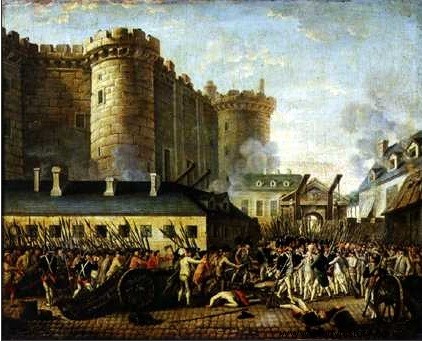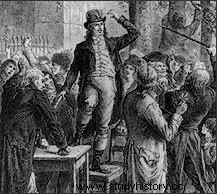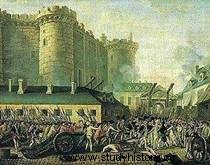 The storming of the Bastille July 14, 1789 is a highly symbolic event of the French Revolution. That day, the city of Paris was shaken by a series of riots caused by the dismissal of Necker, Louis XVI's only popular minister. Fearing a coup from the king, the people of Paris are looking for weapons. After the attack on the invalids where rifles were seized, the insurgents moved towards the Bastille and its powder reserve. After a brief battle, the fortress capitulated and its garrison was partly massacred. Louis XVI was then forced to recall Necker, to remove his regiments from the capital, and to go to Paris on July 17 to receive the tricolor cockade of the patriots. Celebrated a year later on Federation Day, July 14 became a national holiday in 1880.
The storming of the Bastille July 14, 1789 is a highly symbolic event of the French Revolution. That day, the city of Paris was shaken by a series of riots caused by the dismissal of Necker, Louis XVI's only popular minister. Fearing a coup from the king, the people of Paris are looking for weapons. After the attack on the invalids where rifles were seized, the insurgents moved towards the Bastille and its powder reserve. After a brief battle, the fortress capitulated and its garrison was partly massacred. Louis XVI was then forced to recall Necker, to remove his regiments from the capital, and to go to Paris on July 17 to receive the tricolor cockade of the patriots. Celebrated a year later on Federation Day, July 14 became a national holiday in 1880.
The context of the storming of the Bastille
Since the opening of the Estates General in May 1789, France – and Paris in particular – has been living in an increasingly unstable period. The Oath of the Jeu de Paume (June 20, 1789), the proclamation of the Constituent Assembly on July 9, confirm the momentum that will become revolutionary. But it is above all the dismissal of Necker, on July 11, which sets fire to the powder.
 The Parisian bourgeoisie has been organized since June 1789 within the framework of electoral assemblies for the Estates General, and it begins to rebel with the people the day after the dismissal of Necker, judged by the royal power as "condescending towards the meeting of the States General". In fact, the people of Paris feared that the ousting of Necker would cause prices to explode, bread in particular. However, the economic context is already extremely tense and food shortages are not uncommon. Moreover, Louis XVI's choice to replace Necker with Baron de Breteuil raised fears of a coup, especially since troops had been surrounding Paris since the end of June.
The Parisian bourgeoisie has been organized since June 1789 within the framework of electoral assemblies for the Estates General, and it begins to rebel with the people the day after the dismissal of Necker, judged by the royal power as "condescending towards the meeting of the States General". In fact, the people of Paris feared that the ousting of Necker would cause prices to explode, bread in particular. However, the economic context is already extremely tense and food shortages are not uncommon. Moreover, Louis XVI's choice to replace Necker with Baron de Breteuil raised fears of a coup, especially since troops had been surrounding Paris since the end of June.
The troubles in Paris thus began on July 12, 1789 in the Tuileries gardens when Camille Desmoulins, a pamphleteer renowned for his impassioned speeches, harangued the crowd, announcing a "Saint- Bartholomew of the Patriots". The Prince of Lambesc's dragoons must charge the demonstrators, who are assisted by French guards. The stock market closes, a bourgeois militia is set up at the Town Hall, despite the reservations of the provost of merchants Jacques de Flesselles. On July 13, the revolt spread to all of Paris. We must now find weapons...
The rioters seize the Invalides
 At the end of the afternoon, July 13, the rioters send a delegation to the Invalides to demand weapons . Faced with the governor's refusal, a crowd of several tens of thousands of Parisians marched on the Invalides on the morning of July 14. Despite the guns that are supposed to defend it, the place does not retaliate and the people come in force to get their hands on all possible weapons, especially rifles. It is thus more than forty thousand rifles, but also cannons, which are taken from the Invalides.
At the end of the afternoon, July 13, the rioters send a delegation to the Invalides to demand weapons . Faced with the governor's refusal, a crowd of several tens of thousands of Parisians marched on the Invalides on the morning of July 14. Despite the guns that are supposed to defend it, the place does not retaliate and the people come in force to get their hands on all possible weapons, especially rifles. It is thus more than forty thousand rifles, but also cannons, which are taken from the Invalides. The crowd then pressured the City Hall delegates to obtain gunpowder from the Governor of the Bastille, de Launay. A delegation is sent to the fortress. On the eve of its capture, the Bastille was an impressive fortress but not very full of prisoners, nor very defended in troops, except by a regiment of Swiss. On the other hand, it has substantial artillery (fifteen guns) which can enable it to hold a siege for a certain time.
However, Governor de Launay does not seem to want to show great zeal in defending it. The representatives of the people come to the Bastille to demand arms and especially gunpowder. Their intention was therefore not, at the outset, to take the fortress. However, curiously, it was during the morning negotiations that the tone and the tension rose. The governor, who was initially unaware of the capture of the Invalides, agreed to withdraw his guns, accused of threatening the people of Paris. Then, his hesitations in the negotiations begin to agitate the crowd coming from the Invalides, and they begin to demand no longer arms but the surrender of the fortress.
The storming of the Bastille (July 14, 1789)
It is in some confusion that the first blood is spilled. The crowd around the Bastille has become substantial, and especially more and more offensive at the start of the afternoon. De Launay had to retreat to the fortress itself, leaving the first two outer courtyards to the rioters. Looting, including that of the Hôtel du Gouverneur, has begun.
 It would appear that as protesters tried to go further, the garrison opened fire, perhaps - be by deterrence. However, we begin to count deaths among the attackers, and the anger goes up a notch. Governor de Launay is branded a traitor, and the negotiations become increasingly difficult and confusing, with the crowd spiraling out of control. Launay panics and orders to open fire to deter the attackers. He gets the opposite…
It would appear that as protesters tried to go further, the garrison opened fire, perhaps - be by deterrence. However, we begin to count deaths among the attackers, and the anger goes up a notch. Governor de Launay is branded a traitor, and the negotiations become increasingly difficult and confusing, with the crowd spiraling out of control. Launay panics and orders to open fire to deter the attackers. He gets the opposite…
Coming from the Invalides and led by a certain Hulin, some Parisians arrived at the foot of the Bastille around 3:30 p.m. with a few cannons. They fire on the fortress, galvanizing the crowd. The defenders of the Bastille retaliate, but curiously without using their artillery. This does not prevent the number of deaths from increasing among the attackers, and the anger from rumbling more and more.
We now demand the opening of the Bastille, but de Launay refuses if the lives of the besieged are not guaranteed. The fight, still confused, continues. But the Parisians still haven't figured out how to cross the ditch... For some unknown reason and by whom, the drawbridge finally lowers, allowing the crowd to rush into the Bastille and begin to loot it. . Governor de Launay is captured and, taken to the Hôtel de Ville, he is executed. A butcher, Desnot, is in charge of decapitating him and his head is brandished on the end of a pike by the people. Jacques de Flesselles, accused of having played a double game, suffered the same fate. The victors of the day, meanwhile, count in their ranks a hundred dead.
The Bastille is looted all night, its prisoners freed. The importance of the storming of the Bastille was quickly understood by the various actors, except perhaps by Louis XVI who, in his diary, would have written:"July 14:nothing" (it is in fact his record of hunting that he speaks, but the "legend" is tenacious). However, the consequences were almost immediate:on July 16, the king had to recall Necker and, on the 17th, undertake to wear the tricolor cockade when he came to the town hall. The movement leaves Paris, the Revolution continues its work, the storming of the Bastille ultimately acting as an accelerator.
From Federation Day to July 14 National Day

From the following year, July 14, 1790 , at the instigation of La Fayette, is organized on the Champ-de-Mars, the feast of the Federation, the date chosen to commemorate the anniversary of the storming of the Bastille in Paris (there were other feasts of the Federation in France the previous weeks). Nearly one hundred thousand people attended, including departmental representatives, deputies, and Louis XVI himself.
Extraordinary spectacle according to all witnesses, the feast of the Federation occupies a special place in the celebrations of the Revolution. At the origin are the provincial federations of patriotic militias. Thus was born the idea of a Federation uniting Paris and the departments, royal troops and national guards, the king and the nation under the aegis of the law. The real party, however, takes place outside the official celebration. Before, when Parisians of all conditions participate in the development of the Champ de Mars; afterwards, when from July 15 to 20 we dance at the Bastille or on the illuminated Champs-Élysées. The Federation itself is more of a military parade, followed by a mass celebrated by Talleyrand on the altar of the fatherland and the civic oath pronounced by La Fayette. The king then takes an oath to the Nation and to the law.
Finally, on July 6, 1880, on Raspail's proposal, July 14 was declared a national holiday, in reference to the Federation Day of 1790. It is therefore this last that we celebrate, not directly the storming of the Bastille.
Bibliography
- J. Godechot, The Storming of the Bastille (July 14, 1789), Folio histoire, 1989.
- G. Chaussinand-Nogaret, The Bastille is taken, Complex editions, 1988.
- M. Vovelle, The Fall of the Monarchy (1787-1792), History Points, 1999.
- C. Quétel, “Why did the Bastille not defend itself? », in History, no 364, May 2011, p 80-84.
